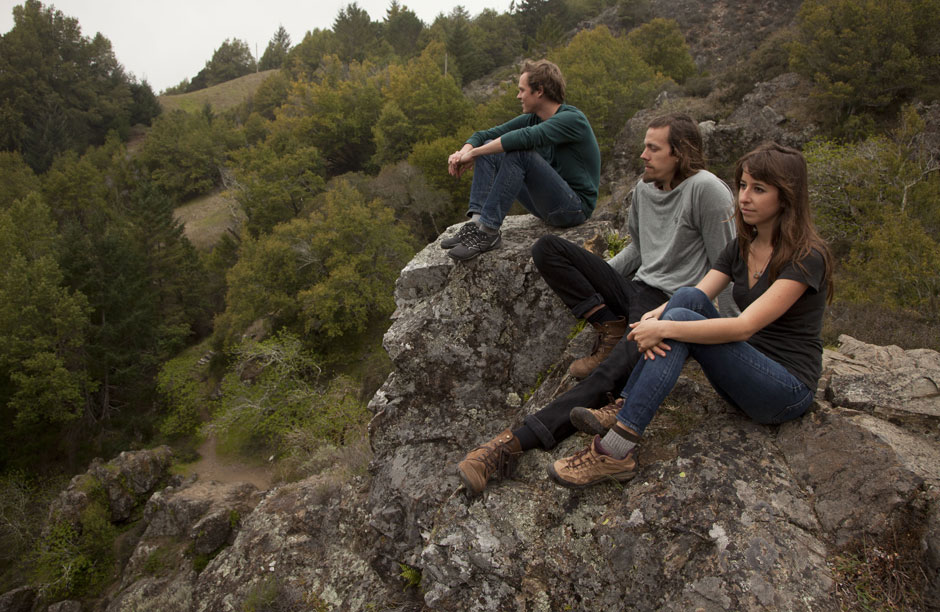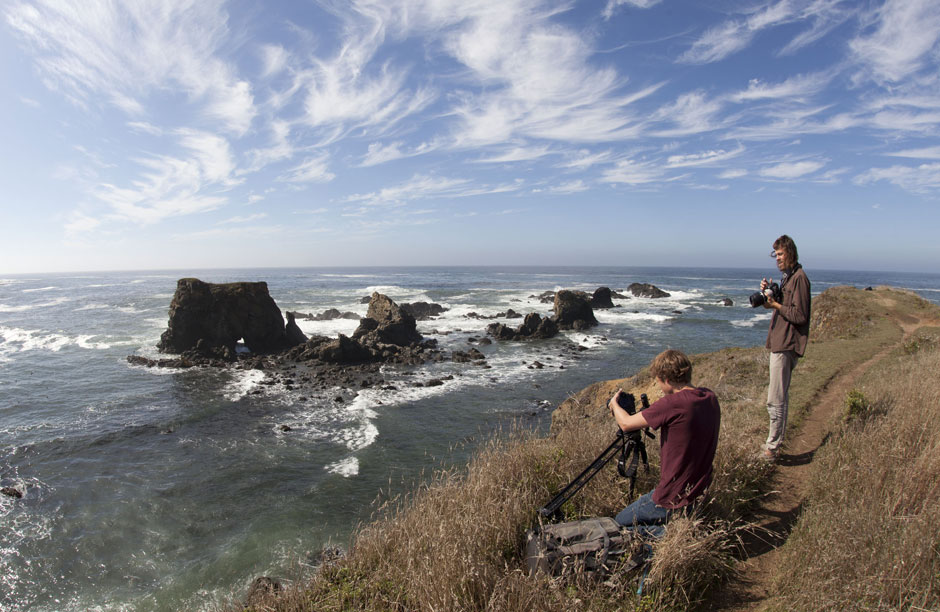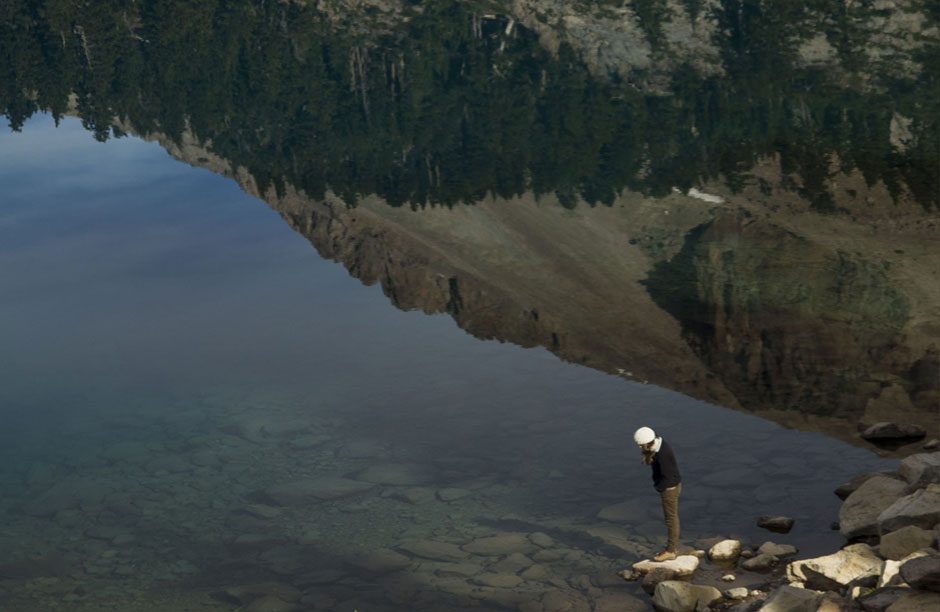PAST ISSUES
 These 3 "Action Heroes" captured on film the pristine and wild beauty of 70 of California's National Parks slated for closure at the end of this year. Ironically, 70 years ago Ansel Adams captured the same land on film as part of a campaign to protect those lands through the national parks system established by President Theodore Roosevelt. Image details: (In order from nearest to farthest) filmmakers Lauren Valentino, Corey Brown, and Jarratt Moody.
These 3 "Action Heroes" captured on film the pristine and wild beauty of 70 of California's National Parks slated for closure at the end of this year. Ironically, 70 years ago Ansel Adams captured the same land on film as part of a campaign to protect those lands through the national parks system established by President Theodore Roosevelt. Image details: (In order from nearest to farthest) filmmakers Lauren Valentino, Corey Brown, and Jarratt Moody. Filmmakers Jarratt Moody (left) and Corey Brown (right) during the making of "The First 70" shot over 120 days while visiting the 70 National Parks slated for closure in the state of California.
Filmmakers Jarratt Moody (left) and Corey Brown (right) during the making of "The First 70" shot over 120 days while visiting the 70 National Parks slated for closure in the state of California. Filmmaker Lauren Valentino during the filming of "The First 70". All video and Images courtesy of Heath Hen Films
Filmmaker Lauren Valentino during the filming of "The First 70". All video and Images courtesy of Heath Hen Films
Ghost Parks
By Sarah Harrison GriggCalifornia is littered with Gold Rush remnants – mining towns filled with skeletal clapboard buildings, the dark, dirt-floored corners of which mark the points where history took place. Most of us conjure a more or less uniform image of such sites: the information panels featuring sepia tone photographs of stern pioneers glowering at us, bearing saws and pick axes, appearing so comical-cum-dreary to the post-materialist mind.
Consider a similar case of human abandonment. What would happen if our species suddenly vanished from public lands? Would the forest take its course, quietly absorbing trails, campsites, roads, taking them back to the soil whence they came? How does a ghost park look? Californians are scheduled to find out.
In May 2011, California State Parks made a quiet announcement. Seventy state parks, representing one fourth of the state’s total, would be closed by July 2012 due to budget cuts, a decision intended to save $22 million over two fiscal years. With the closure of parklands, recreation areas, wildlife preserves and historic parks, thousands of acres of public land would suddenly be off limits to the people of California and beyond.
The decision received little media coverage, but fortunately, a local newspaper article caught the attention of Lauren Valentino, a young fashion designer living in San Francisco. Valentino and her boyfriend, Jarratt Moody, both graduates of the Savannah College of Art and Design, worked in the city for nearly three years following their graduation.
“To get away on weekends, we explored the public lands outside the city. The landscape variety here is astonishing,” said Valentino. When she heard about the closures, she wanted to take action. She set out to make a film.
“At first it was a crazy idea, and we just thought, ‘Wouldn’t it be an amazing adventure to get involved with the parks and people. But it became a reality,” said Moody. They called fellow classmate Corey Brown, urging him to head to the West Coast. He was in the midst of a year-long road trip, driving through New Mexico in an airport shuttle van converted to run on waste vegetable oil: “I was already on the road, so I thought, ‘Why not?’”
With Valentino as producer and the other two as cameramen, the team set out across the state in Brown’s quirky van to produce The First 70. Over the course of 120 days and working on their own funds, the filmmakers covered the issue first-hand, collecting interviews with park rangers, public lands activists and recreationists capturing the stunning landscapes that would be barred to the public.
None held previous film experience, other than toying with digital video cameras. “We initially had to stop and ask ourselves, ‘Is this a documentary about Parks or a bad version of Planet Earth?’ It’s hard not to focus on only shooting nature when you’re out there, but as we talked to more experts, we decided it was really important to focus on the economic issue of the closures,” said Brown.
That decision produced a piece that surpasses mere scenes of nature overlaid with the sounds of a string quartet. The First 70 artfully weaves human stories with hard ecological and socio-economic facts. Valentino described interviewing a young park employee who would soon lose her position as a docent at a historic park: “She was so utterly passionate about her job and the place. Listening to her talk about school groups losing the opportunity to learn about California state history was moving.”
As for the ecological repercussions, one might be enticed to imagine the closed parks reverting to some pristine version of “wildness,” but this is not pre-colonial North America. This is modern-day America with three-fourths of our 350 million U.S. citizens living within a day’s drive of access to state or federal public lands.
These are lands on which Americans are hiking, camping, fishing, hunting, and learning about local ecosystems and history. These are likewise lands where people are poaching wildlife, cooking meth, growing marijuana, introducing invasive species, dumping toxic waste, starting forest fires and constructing vacation homes against the borders. Closing the gate does not equate to keeping people out. Addressing these negative anthropogenic impacts has challenged under-staffed and under-funded park crews for years and will doubtlessly intensify, in spite of the state’s promised effort to monitor closed sites. Cleaning up after or preventing these problems will generate costs which have not been clearly identified. The film argues that re-opening the parks after a period of closure will be more expensive than continuing park operations on skeleton crews and low budgets.
“We thought as we filmed that we might change our perspective and come to understand that this was some sort of shared sacrifice for Californians that would benefit the state. But as we learned more about it, it became clear that money would not be saved, which totally negated the rationale of closing the Parks,” commented Moody. As he noted, vandals recently destroyed $15,000-worth of plants and equipment in Candlestick Point State Recreation Area, slated to close in July. This represents a mere scratch in the damages that will inevitably occur once the lands officially shut down. Furthermore, many of these sites recently completed, or were in the stages of completing significant restoration projects.
“Just about every park had a story about a multi-million dollar project that was already taking place and that would keep going, even after the gates were closed,” explained Valentino. For instance, Leland Stanford Mansion State Historic Park in Sacramento just completed a $22 million restoration project on its Victorian architecture, a price equal to the amount projected to be saved through the state-wide closures.
The monetary damages will extend well beyond park boundaries. Communities on the edges of parks benefit from the dollars of public land users. One interviewed park ranger explained that for every dollar spent at his park, $1.67 was spent in the surrounding local communities. This means that for every $150,000 spent within the park, $250,000 to $300,000 goes to business owners living on the rural fringes.
The situation is forcing communities adjacent to closing parks to take the matter into their own hands. The film is providing a platform for discussion and action. According to Valentino, “At many screenings, audience members have no idea that closures are taking place . . . people who are newly aware seem inspired and tend to donate.” All donations raised through the screenings are directed to local park foundations.
“The sad thing is, some of these parks are way out there and only have a small town nearby. They don’t have the non-profit or donor infrastructure to keep the park open,” said Moody. Communities in rural locations may not have the financial means to prevent a closure, but these remote lands often provide unique wilderness and habitat qualities, as well as important ecosystem services, that lands closer to urban areas do not. Losing these “out of sight, out of mind” parks represents the potential degradation of critical wildlife habitat, aquifers, wetlands, and other invaluable natural features.
Of late, several prominent politicians have suggested privatizing public lands, exemplifying a stance shared by many members of our legislative body. These representatives underestimate how open spaces impact landscape-scale ecosystems, contribute to local economies and shape our national character. Combine this mentality with the current cuts, and things do not bode well for public lands across the nation, state or federal. This is not an issue of black or white, left or right, but rather one of ecological illiteracy across the board.
“It’s such a misunderstanding of how important this is to the public. The preservation in this state and the abundance of natural resources are why many people choose to live here,” said Brown.
The case for closing public lands in California provides a mirror for other states and the federal government, all of which are looking at public spaces and the bureaucracies that manage them as frivolities that can be snipped away. At a time when many people cannot afford long-distance travel, when childhood obesity is at its apex, and when hunting tag sales are going up as people seek to fill the freezer (thereby increasing funding for wildlife conservation), taking away public lands seems misguided. Studies have shown that the average American high school student can identify African mega-fauna, great white sharks, and other Discovery Channel choice wildlife, but can’t identify animals in their own backyards, such as raccoons, robins, and foxes. The environmental implication for this shortcoming is worrisome, but the cultural implication is equally disturbing—that we, along with our politicians, are becoming a largely disconnected species.
At a national scale, what will become of our parks and other public lands as Congress continues to debate the budget? Will there be high game fencing around the perimeters, posted with “No Trespassing” signs, housing subdivisions within? Or will we stand at closed park entrances and view informational panels, filled with sepia tone photographs of ourselves in ridiculous 21st century outdoor gear, the forest just beyond and out of reach?
Whether these lands are privatized or left to waste, the closures represent a death sentence in which our shared open spaces are relegated to tombs. Our gift to future generations will be living memorials, cul-de-sacs or gated parks standing in remembrance of a public lands legacy that was brilliant in its conception, but disgracefully short-lived.
The First 70 is currently showing at venues across the state of California. For a schedule of screenings, or to view the trailer, visit www.thefirst70.com.